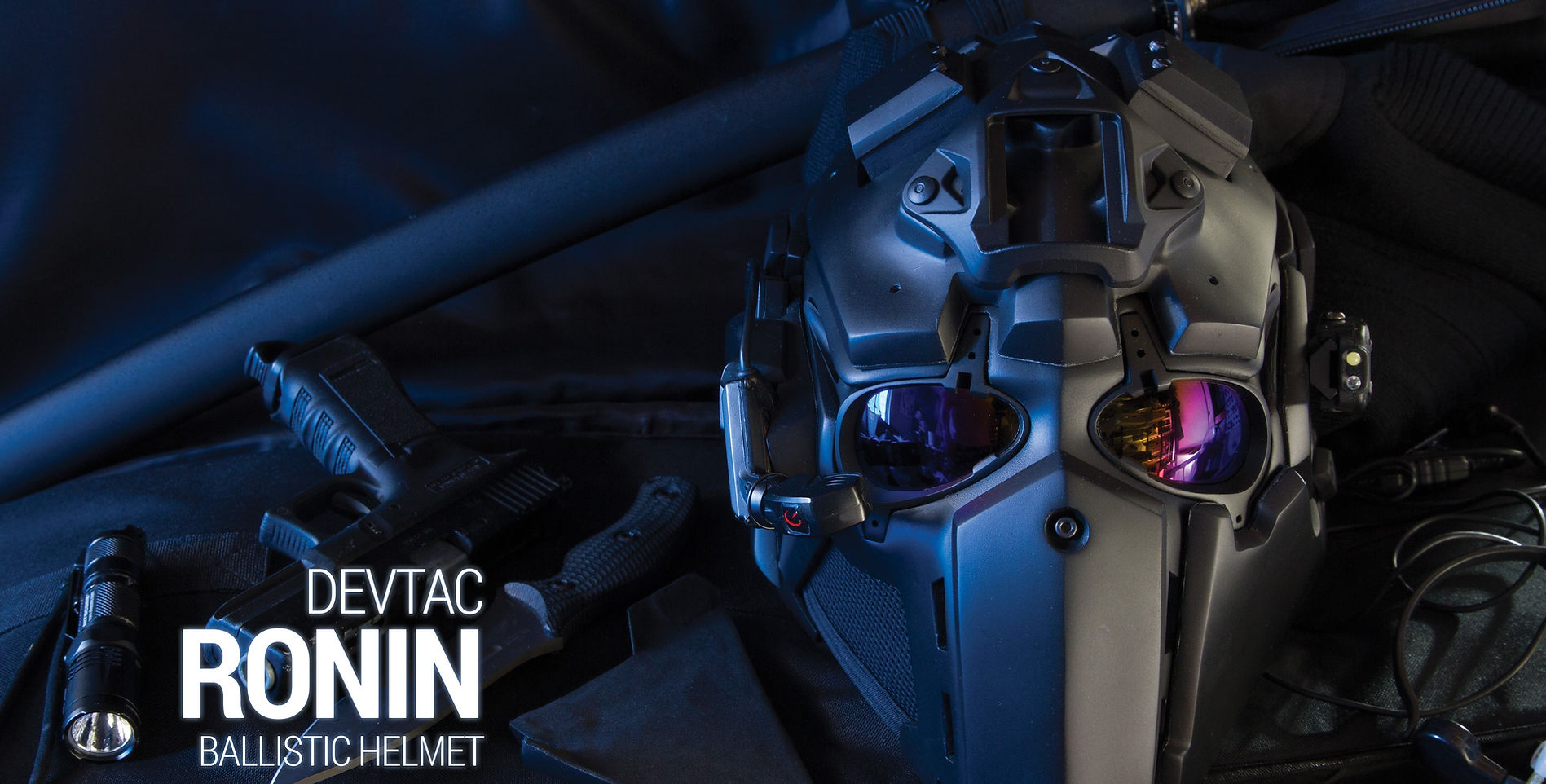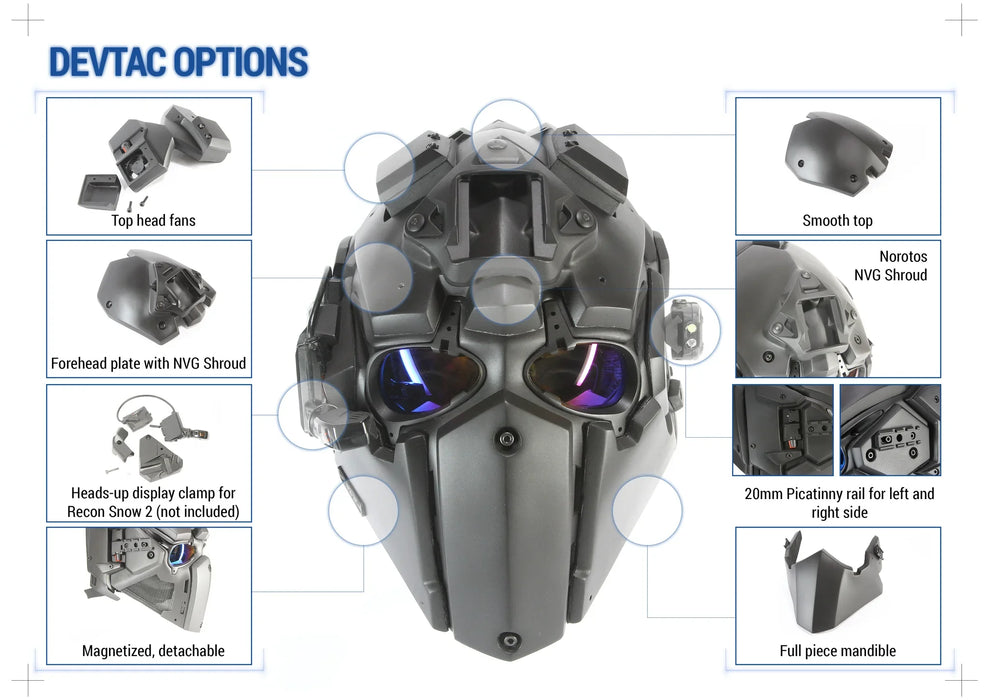Views: 0 Author: Site Editor Publish Time: 2025-10-15 Origin: Site
- Development start (R&D launch): Reports indicate the DevTac Ronin helmet project began development as early as 2004 in Yokohama, Japan. The project received ongoing R&D investment from the Japanese company or DevTac-related team.
- Public debut and media coverage: Ronin entered the international public eye around 2017 — multiple industry media outlets and defense/equipment platforms reported or showcased Ronin (including appearances at defense/security expos and subsequent media reviews in 2017), making it a widely noticed “futuristic” full-face ballistic helmet example. Media and evaluations in 2017 published images, specifications, and NIJ-related test information.
- Channels & promotional materials: Afterward, DevTac released brochures and overseas dealers (such as Atomic Defense, Security Pro USA) marketed Ronin globally; company sites and trade show materials further detailed product specifics.
Summary: Ronin’s core R&D traces back to 2004 (Yokohama, Japan), and it made its international media and exhibition “debut” around 2017, subsequently entering commercial sales and distribution channels.

DevTac Ronin is a modern tactical helmet/face system centered on full-face coverage + modular expansion. It integrates traditional helmet crown protection with facial and jaw protection, along with detachable visors, ventilation/anti-fog systems, NVG/HUD/streaming camera interfaces, and modular ballistic panels — transforming the “helmet” into a head-borne tactical platform. The manufacturer is stated as Japan-origin, and the product is sold globally through overseas distributors.
Modular shell & detachable visor: Ronin uses a "shell + detachable visor/cheek/jaw plates" architecture. The visor attaches via magnetic/plug/quick-release fittings for rapid reconfiguration or maintenance between missions.
Multi-layer composite ballistic body: Main shell and panels are typically made from aramid/Kevlar or multi-layer composite materials, combined with shock-absorbing padding. Different sections can use different thicknesses/materials to balance protection level and weight.
Anti-fog & ventilation: To address fogging issues in full-face systems, Ronin integrates ventilation channels and micro-fan/anti-fog design (or inner lining structures that facilitate airflow) to keep visibility during close observation and shooting.
Accessory & electronics interfaces: The helmet is compatible with NVG mounts, accessory rails, HUD and external camera/stream modules, allowing the helmet to act as a head-worn information platform and integrate lights, comms and video streaming.
Ergonomic inner lining: Multi-point padding and adjustable liners balance fit and comfort to reduce fatigue during extended wear. Makers claim relative weight reduction depending on configuration.

Note: Different versions and distributor listings vary. The below items are common data points found in public channels; when purchasing, always ask the supplier for formal test certificates and samples.
Protection rating: Public information shows some Ronin variants are labeled within the NIJ IIIA range (resistant to handguns and high-energy pistol rounds such as .44 Magnum) — confirm with batch-specific test certificates.
Coverage: Marketing often cites “80%–90% head coverage” (including facial and lateral neck protection), with exact figures varying by version.
Weight: Sources list weights commonly in the ~2.0–2.3 kg (4.4–5.1 lbs) range depending on whether ballistic panels, respirator modules, or HUD units are fitted.
Multi-hit capability & layer count: Ronin typically uses stacked thin plates with cushioning layers (rubber/foam) to disperse kinetic energy; manufacturer descriptions detail panel thickness and absorption layering, but independent multi-hit test reports are needed to assess real-world capability.
Base full-face ballistic version: Emphasizes facial and lower jaw protection with replaceable panels.
Respirator-integrated version: Integrates breathing filter interfaces or soft filtration elements, combining ballistic and respiratory protection (marketed as Ronin Respirator).
Tactical-integrated version (HUD / streaming camera): Features HUD mounts, streaming camera interfaces and expanded rails for advanced situational awareness needs.
Close quarters battle (CQB) & urban operations: Ronin’s facial protection reduces fatal face/neck injuries from fragments and close-range projectiles during door entries and room clearing; integrated windows/camera interfaces support covered observation.
Law enforcement entries & hostage rescue: SWAT units performing high-risk entries can benefit from increased head-and-face survivability and the ability to rapidly attach night vision or cameras for command-level oversight and evidence capture.
Protection & VIP escort: For high-threat VIP transport, Ronin offers more comprehensive head protection for both guards and protectees.
High-risk reconnaissance / counter-weapon operations: Combined with respirator variants, Ronin has extended application where toxic smoke or chemical threat elements are present (but must be used alongside dedicated CBRN equipment).
Training & demonstration: Its futuristic appearance and high recognition value suit demonstrations, training media and promotional use.

- NIJ testing & third-party certification: Media and certain retailers claim Ronin ballistic panels tested by independent labs (e.g., NTS) and reached IIIA performance. However, tests can vary across batches and panel combinations — buyers must request batch-specific certificates.
- Usage limits & misconceptions: Some communities portray Ronin as “battlefield-level full protection,” but experts note it is generally more suitable for urban/law-enforcement protection (handgun rounds & fragments). Rifle protection typically requires additional hard plates or rifle-rated modules.
Advantages:
Large coverage protecting face, jaw and normally exposed areas;
Modular and extensible for NVG, HUD and cameras;
Distinctive design useful for high-end clients and demonstrations.
Limitations:
Heavier and bulkier than lightweight helmets, impacting long-duration mobility;
Advanced modules and panels increase cost and maintenance needs (visors, seals, fans);
Not inherently rifle-round proof without additional armor modules or specific rifle-rated panels.
Regulatory risk: Ballistic helmets may be controlled items in some jurisdictions; verify import rules and required permits for destination countries.
Document preparation: Prepare test certificates, origin documents and material composition sheets for customs or customer inquiries.
Logistics strategy: Use carriers experienced in security/military shipments; avoid sensitive wording on export paperwork and insure high-value shipments.
Q: Can Ronin stop rifle rounds?
A: Public tests indicate Ronin delivers good handgun-level protection (IIIA range) for pistol rounds and fragments. It is not guaranteed to stop rifle rounds (e.g., 5.56×45, 7.62×39) unless paired with rifle-rated hard plates and certified accordingly. Always request test certificates before assuming rifle protection.
Q: Who invented/made this helmet and where is it produced?
A: Ronin’s development was led by a DevTac team and is described as Japan-origin; it is sold worldwide via multiple distributors. Buyers should request origin and testing documents from their channel to verify provenance and compliance.
DevTac Ronin earns the “from-the-future” label by combining full-face protection, modular expansion, and tactical electronics integration in a commercially deliverable form. For units focused on urban entries, law enforcement penetration and high-threat escorting who need improved head-and-face survivability, Ronin demonstrates a compelling design direction. However, procurement must be governed by clear mission requirements, strict third-party test verification and compliance checks.
Click here to view more Loop circle equipment
If you are Interested in high-quality ballistic helmet, Bulletproof-Shield, ballistic plate, ballistic vest, or other tactical accessories, contact us today. We provide professional-grade solutions, competitive pricing, and fast delivery to build a reliable tactical system for your needs.